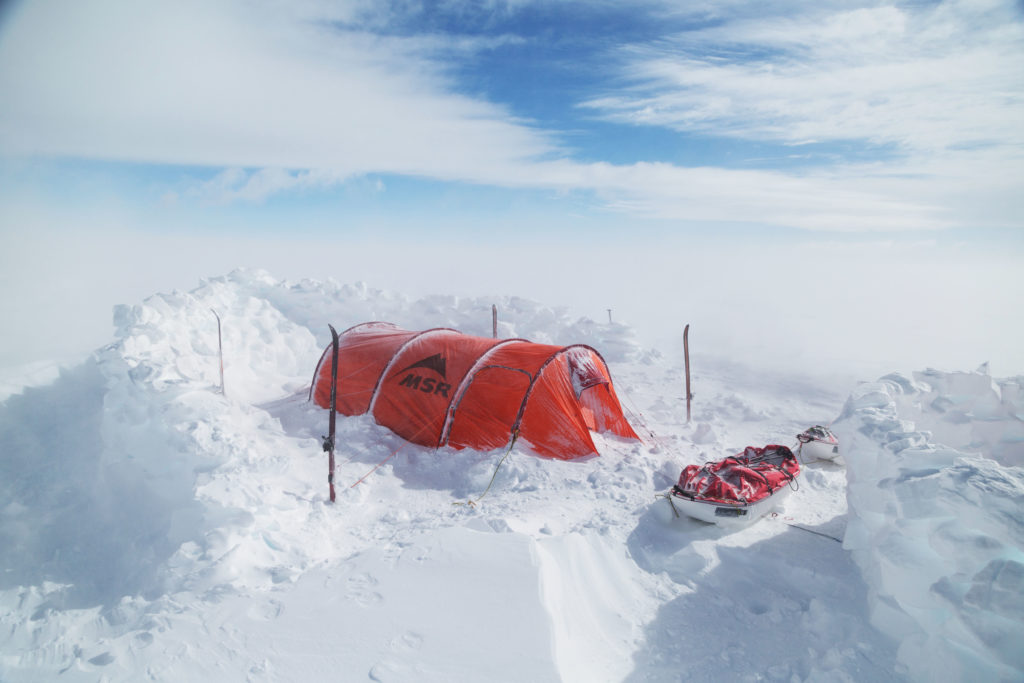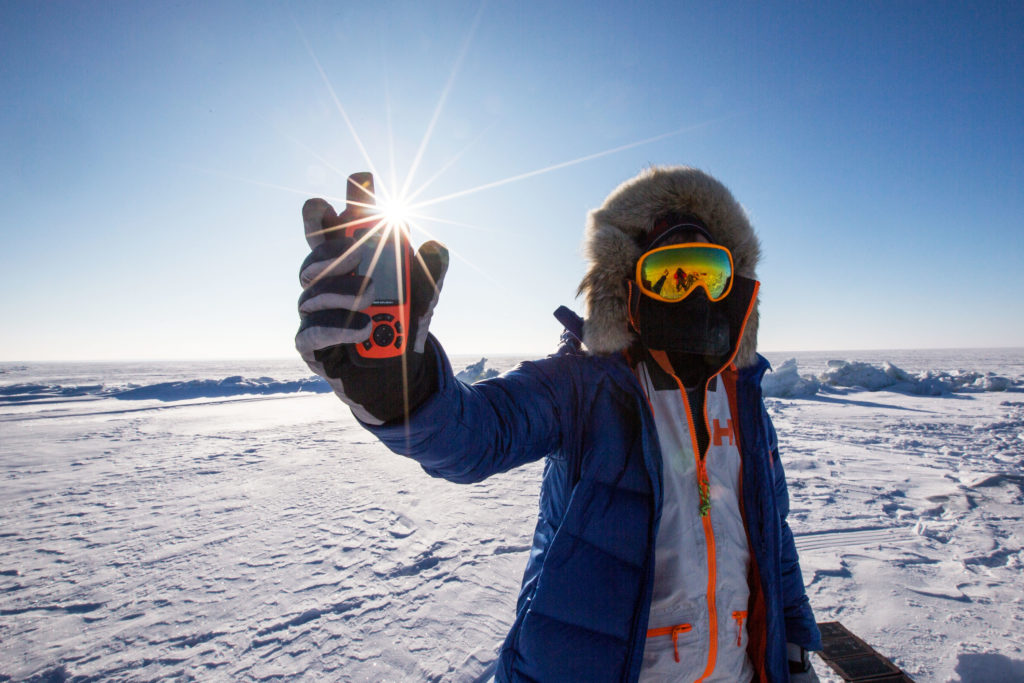Q&A With Sponsored Athlete Eric Larsen
Polar adventurer, expedition guide, dog musher and educator, Eric Larsen has spent nearly two decades of his life traveling in some of the most remote and wild places left on earth. He is the first person to go to the South and North Poles and climb in Everest in one year. In his own words, he thinks it’s “cool to be cold”. We caught up with this Garmin Sponsored Athlete after his latest expedition to Greenland.
Q: Walk us through why you chose Greenland for this expedition?
EL: While I have been to Greenland on several occasions, I had never done a crossing of the ice cap. As I expand my guiding business, I am always looking for new and challenging adventures for clients. This particular crossing actually has famous roots as it was the route first pioneered by Fridtjof Nansen in 1888 which was the first ever crossing of the ice cap.
Q: Who was with you on this trip?
EL: This was one of my guided expeditions where I was leading three international clients – from the US, England and Brazil. All were experienced adventurers / climbers.
Q: What is the most common mistake people make during cold weather expeditions? And how do you beat winter?
EL: Surprisingly, one of the most common mistakes that people make during cold weather expeditions is getting too hot. We work fairly hard on trips like this, and as a result, our our bodies produce a lot of heat and sweat. Stop for too long in below zero conditions in sweaty clothes and hypothermia will set in. Too often people ignore changing conditions – and don’t stop to adjust (either adding or subtracting layers). Similarly, not reacting to any change – in weather, surface conditions, or your own physical or mental state can have disastrous effects as well.
The key is to not necessarily beat winter but understand it and adapt to changes as you encounter them.

Q: When leading these guided expeditions how do you ensure the safety of the group?
EL: Leading people on expeditions in extreme environments is difficult. You can go from status quo / all systems normal to a survival situation in a matter of minutes. Obviously, having the right clothing and equipment is critical so I spend a lot of time ensuring each person has the right gear. Generally speaking, my goal is to take small steps – teaching smaller skills first then moving on to larger concepts and planning. In polar travel, we have a fairly scripted routine that dictates what we do each day – both to conserve energy and maximize (and minimize at times) resources. Having a structured travel day where everyone knows their role is critical. Equally important, is the art of self reliance. In these situations, I try to ensure that each team member is taking care of themselves first — recognizing and adapting to change on an individual level, then expanding their efforts outward to others. When each person is functioning at a high level, our team has a better chance of both safety and success.
Q: What gear did you take to Greenland? And how do you decide on supplies for your expeditions?
EL: For a trip like this, we are carrying everything that we need to live and survive for nearly a month in lightweight sleds that we pull behind us while skiing. Therefore, both the weight and utility of each item has to be thoroughly vetted. That said, I’ve been doing polar style expeditions for nearly 20 years so my gear list is fairly refined. While I am focused on reducing as much weight as possible, this type of environment can destroy even the most robust of gear. Therefore my basic philosophy is “not light but right”. I choose gear that I’ve either used on previous expeditions or have tested prior to departing. It has to be both durable, easy to use / operate in extreme climates, repairable and hopefully as light as possible. There are a few items that are so critical that I take a back up (like camp stove). The rest is either totally bomber or can be repaired (sewed, glued, screwed, etc).
Q: Let’s talk about the elements. What was the average temperature? How did weather play a factor in this trip? What obstacles did you encounter and overcome?
EL: By all accounts the weather this year in Greenland was some of the worst that region has seen in recent times. We were traveling in May and June where temperatures started out just around freezing (32º F). Once we attained the main ice cap it was generally in the single digits, while near the East Coast we had temperatures often above freezing and it even rained one day!?
Weather played a huge role in our journey as it was constantly changing and bad storms dramatically affected our ability to make forward progress. We seemed to go from epic storm to calm and warmer temperatures to epic storm to brutal headwind to epic storm to deep snow. There was never a moment where we could just relax and go with the flow. Quite honestly, the severe weather made things both very difficult and very dangerous. Still, that’s the nature of this type of travel and we constantly adapted our plan to be able to move forward. Equally important to us was simply having a reliable weather forecast so that we could modify plans due to impending storms. The inReach Explorer+ proved to be an invaluable tool in this capacity.
Q: What role did inReach play in this project?
EL: This may sound a bit like hyperbole, but without the inReach on our Greenland ice cap crossing, I would have died. Having hourly (very) accurate weather forecasts allowed us to modify our travel schedule and prepare for approaching severe weather. On several occasions, we stopped skiing simply to build snow walls and create a “gale proof” camp. With 60 and 70 mph wind gusts our tents would have blown away unprotected and left us exposed to windchills of 40 or 50 below…
Of course, the inReach does so much more too (which is why I love it so much). Having reliable two way communications is key for coordinating logistics (helicopter pick up, etc) as well as being able to text friends and family. I’m on expeditions for large chunks of the year, so being able to easily check in with my wife and kids is very important to me. I also like that I can share my adventures and my location on social media.
I also used the tracking and GPS features. Charting our daily progress toward waypoints. Knowing our location. Charting our exact route. These are critical components of any modern-day adventure. Even more important than all that, of course, is the SOS functionality.

Q: Was there a time that you were more frightened than confident?
EL: There are a million little moments where self doubt and fear chip away at my confidence. A trip like this is a chess game that plays out over not just a couple of hours, but for days and weeks. Therefore, any problem can eat away my spirit. Gear failures, logistics, managing food and fuel reserves, these are all facets of this slow moving drama that plays out in one of the most remote places on the planet. Anything can go wrong. For example, I fell partway into a crevasse early on and was shaken up a bit. Worse, however, were some of the most intense storms I’ve ever experienced where I seriously considered that we might need to get rescued. With snow piling up on our tents and gale force winds beating us down, I was… worried – to put it mildly.
Q: How far were you traveling each day? How do you keep your mind busy during the treks?
EL: On a trip like this, I base my travel day on time versus distance. Surface conditions and weather can change so much that our progress varies significantly from day-to-day. Additionally, and because the trip is so long, we have to ensure that we are getting enough rest during the first couple of weeks. When we get closer to achieving our objective, I modify our travel and rest times depending on the amount of resources (food / fuel) we have left and our overall logistics schedule. Regardless, we are usually outside and traveling for 10 or more hours each day.
Traveling in open spaces like this with little or no scenery is as mentally challenging as it is physically difficult. Keeping your mind occupied each day while staring at distant horizon – or worse – the milky white nothingness of a white out is not easy. I rely a lot on music and podcasts to get through each day, but I’m also a good day dreamer and on good days (there aren’t a lot) thoughts drift in and out effortlessly.
Q: Now that you’ve accomplished this, what is your next challenge?
EL: Summer is my slow time (it’s too warm) but I’m working on expanding my guiding programs to include some more polar trips as well as Fat Biking in the Arctic. I am also planning a big polar expedition in the near future (details coming soon).
Think Snow!
The post Q&A With Sponsored Athlete Eric Larsen appeared first on Garmin Blog.
Sample Block Quote
Praesent vestibulum congue tellus at fringilla. Curabitur vitae semper sem, eu convallis est. Cras felis nunc commodo loremous convallis vitae interdum non nisl. Maecenas ac est sit amet augue pharetra convallis nec danos.
Sample Paragraph Text
Praesent vestibulum congue tellus at fringilla. Curabitur vitae semper sem, eu convallis est. Cras felis nunc commodo eu convallis vitae interdum non nisl. Maecenas ac est sit amet augue pharetra convallis nec danos dui.
Cras suscipit quam et turpis eleifend vitae malesuada magna congue. Damus id ullamcorper neque. Sed vitae mi a mi pretium aliquet ac sed elitos. Pellentesque nulla eros accumsan quis justo at tincidunt lobortis denimes loremous. Suspendisse vestibulum lectus in lectus volutpat, ut dapibus purus pulvinar. Vestibulum sit amet auctor ipsum.

